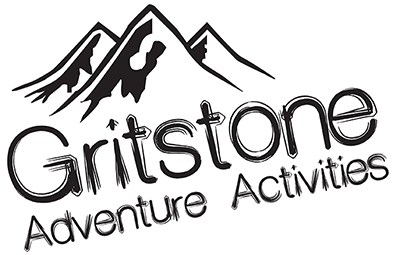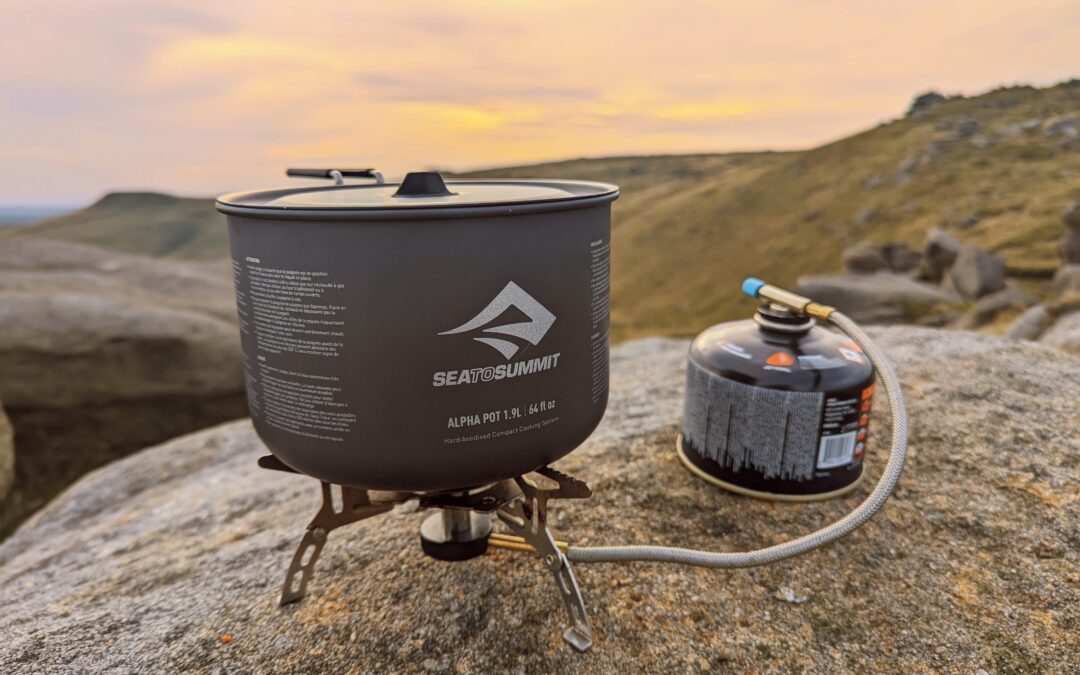
by Alan | Jan 19, 2024 | Gear Review
Aussie Brand Sea to Summit have become a leading force in the UK wild camping scene in the last few years. Their gear is expensive, there’s no doubt about that, but their products are absolutely top-notch quality as well as very well thought out in terms of usability. It shouldn’t matter, but Sea to Summit equipment is just plain cool, so if it matters to you that your rucksack contains only the coolest gear then check out their website here.
Technical features:
The Sea to Summit Alpha pan is a lightweight (230g for this size) aluminium pan. This version holds 1.9L and there are two other sizes – 1.2L and a generous 2.7L version. The pan is coated with a nonstick substance which, thus far, I’ve not managed to weld some food to which is a first for me so the coating must be good! The handle hinges so that it can be swung around horizontally and clipped neatly to the pan’s silicone lid handle. This also closes the lid onto the pan. This closure system is very neat and works very well – there’s obviously been a lot of thoughtful, non-gimmicky design processes here which is great to see.
Real world:
I’ve found this pan to be the perfect size (1,9L) for solo catering while wild camping but I’ve easily cooked for three, me plus my two bottomless-stomached children, with ease using this pan. Having said this the 1.9L size is still small enough to be nice and compact. The pan is very light but also strong and I’ve not yet managed to mark or dent the pan after several wild camping trips. Can a pan look cool? I’m going to stick my neck out and say yes. I’ve never thought of any cookware in my life as “cool,” but I can’t help but regard this pan as an object of technical beauty! It should matter but to me it does.
I picked this up for Just £28 including postage from outdooraction.co.uk Retail price is £45.
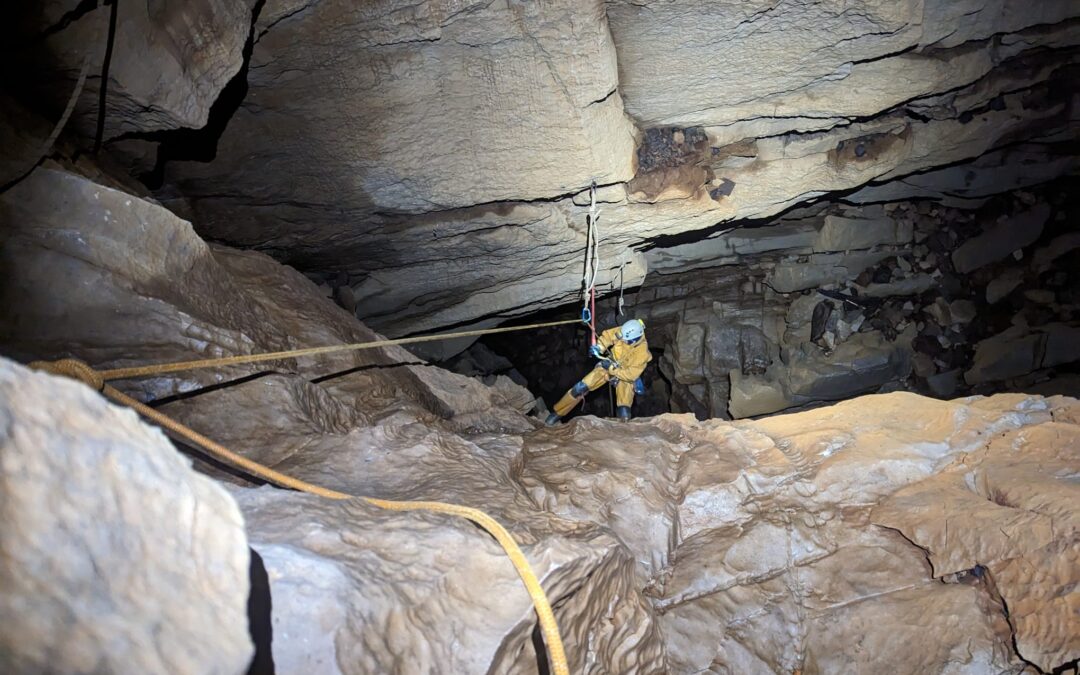
by Alan | Oct 26, 2023 | Caving
I managed to get away to my caving club; “The Yorkshire Subterranean Society” at the weekend for a well-earned caving break. The highlight of the weekend was a trip to Marble Steps Pot in the Lancashire fringes of The Yorkshire Dales National Park.
I was a little concerned that the cave would be impassable since the country had just weathered “Storm Babet.” Marble Steps is known to be very “active” – caver speak for wet, and this cave is known to fill to the roof very quickly from the main chamber downwards. The entrance is also known to flood quickly, with the entrance channels rapidly becoming raging torrents. However, unusually the Yorkshire Dales missed the worst of the storm and the cave turned out to be bone dry – so the trip was on.
The entrance to Marble steps is a large open-air chasm in the ground and the first section of caving is in daylight, accessed by some easy traverses on horizontally rigged ropes. Once in darkness the way on is through fairly narrow and slightly awkward passages which wind their way horizontally into the cave – this area is appropriately named “The Sidewinder.” After some roped up wriggling around we come to the first big pitch into the Mian Chamber. This is an impressive cavern with a broken and irregular shape and is the convergence of the three different ways into the lower part of the cave.
The next pitch down took some working out as it wasn’t a straightforward drop, rather a steep rocky slope down sharp fins of limestone. Here it was important to use rope deviations (where the rope is clipped into bolts on an opposite wall) to keep the rope from rubbing against sharp rock, in order to get down the 30m pitch safely.
We are now into some horizontal caving – a mix of free climbing, walking and crawling to get down to “Stink Passage,” and yes, it was a bit stinky. I was then confronted by a small hole down which we’d need to go. Sceptical that I’d fit down, and even more sceptical that I’d fit up again, I rigged a rope down the hole and squeezed downwards on the rope to access a small chamber. I did fit after all.
After some more horizontal struggling we reached the top of “The Ninety,” named for its 90 foot abseil into the bottom of the cave. This pitch was very hard to rig ropes to as this involved reaching over the drop precariously with the rest of my body wedged into a very tight passage from which I’d start the abseil. After some swearing I managed to rig the rope and we all dropped down to the very bottom of the cave. It’s at the bottom of these large caves that you feel a real sense of commitment, knowing you are deep underground and that the only person who’s going to get you out is you. Perhaps this is why we do it?
After admiring the large and beautiful space we were in, we set off up the rope to retrace our steps to the entrance. Four cavers, 4.5 hours.
I can highly recommend Marble steps to cavers with some experience. This is a large, impressive, varied and challenging adventure which is well worth the effort.
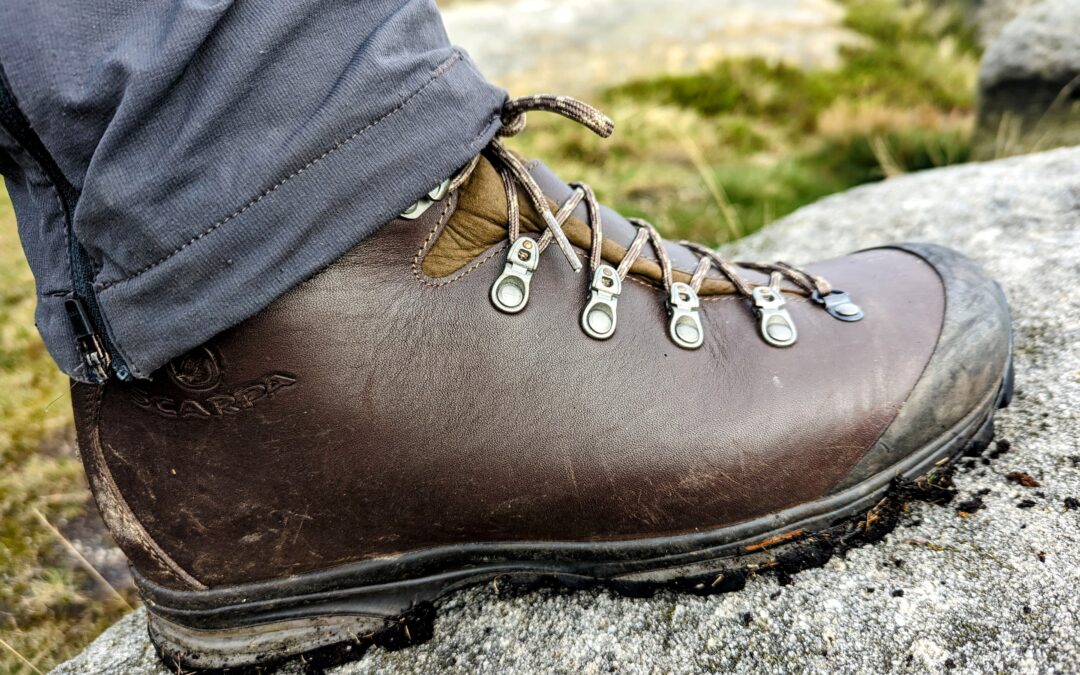
by Alan | Sep 14, 2023 | Gear Review
The Scarpa Delta GTX Activ from the legendary, high quality mountain footwear manufacturer has been around for a few years now. For me, this is one of Scarpa’s most pleasing traits; they make a product that works (and sells) and then they stick with it. Many makers of fine gear change their products on an annual basis – planned obsolescence if you will, so that the customer is always left feeling their version of the product is out of date, leaving them wondering if they need to shell out and get the latest version. Not so with Scarpa who have the confidence, built over decades success, to stick with their impeccably stitched guns.
Take a one look at a pair Scarpa Delta GTX Activ and they just shout “classic mountain boot.” No fancy colours or space aged graphene technology. They are black and brown leather boots. I personally think they look great and will never go out of fashion.
The build quality is obvious from the first sniff of those calf leather uppers. A one-piece wrap around upper with only one stitched seam on the instep where water might think about getting in. Even if water tried, it’s got a layer of Goretex to get through before it reaches your feet – which isn’t happening. Scarpa’s “Speed-lace” steel lacing pulleys are super sturdy, no danger of you kicking them off the boot on a rock. For the tongue and ankle, Scrapa have used a luxurious soft nubuck style leather, possible offcuts from the Rolls Royce upholstery shop, for extra comfort where it’s needed the most. These boots don’t have a full rand, just a toe rand, which may preclude these boots from being purchased by more hardcore, or less nimble mountain walkers though. The soles, Vibram naturally, are big and aggressive and I personally like how the rubber is quite firm. A tougher rubber won’t grip as well on rock where softer rubber would, but I’ve had boots with soft rubber that have ended up looking like Swiss cheese after long walks on the UK’s more rocky summits (think Tryfan or the Scafells), but in the UK’s mostly muddy and grassy hill terrain the harder rubber will keep you from falling on your backside by biting into the mulch. It really depends upon where you envisage using these boots and if you are looking to venture onto mostly rocky terrain you may want to look at Scarpa’s more mountain orientated range such as the Ribelle Lite.
So what are they like to wear? Here’s where these boots may divide opinion. If you are looking for a light, nimble boot for dancing over the trails of the UK’s hills, these aren’t for you. A traditional boot, the The Scarpa Delta GTX Activ is more suited to traditional hillwalking. By that I mean hill walking trails, grass, bog and wet conditions. These are a heavy boot which means they will be bombproof and last many years, but they aren’t for fast and light use or scrambling. For that, you’d need to take a look at Scarpa’s Ribelle range once again. These boots are also stiff, really stiff, but that will suit our perpetually damp hills here in the UK. If you are looking for a long lasting, high quality, stylish boot for a supportive and confidence inspiring hill walking day out – these boots can’t really go wrong. Scarpa’s retail price is £270 but I picked a pair up for £225 from Go Outdoors (August 2023).

by Alan | Sep 12, 2023 | Discussion
Adventurous Activities often include exposure to height, with climbing and mountaineering being the first activities to conjure visions of vertigo in the mind. Although in reality most adventurous outdoor activities involve coping with heights in some way; caving, hill walking, canyoning and even a more adventurous Kayaking. People are often surprised that caving makes the list of at-height activities as we imagine storybook scenes of an arched cave entrance leading to a horizontal passage into a hillside. Of course, it is possible to do more gentle horizontal underground walks, but in reality we have hundreds of caves in the UK that involve vertical passages only accessible by long abseils of 50, 60 and 70 metres or more. In fact, the Peak District’s “Titan” has the UK’s longest drop of 141 metres, that’s around the height of the Blackpool tower.
So how do we set about Enjoying Heights? I think we can divide people into three categories based upon their ability to cope with heights; those that partake in at-hight activities purely for because they want to be high. Those that tolerate heights in order to get their reward; reaching the top of a mountain, or getting to the bottom of a cave because they want to see what’s there. And there are those that just hate heights and believe they can never tolerate them. However, three types have one thing in common – they are not born to love heights and if they say they are they are not telling the truth!
Becoming comfortable with heights is learned. Some people will become comfortable with heights sooner than others, it’s true, but every individual need to develop a number of techniques to be able to function at height. This is done in a number of ways. Just like a muscle, the brain needs to be exercised by a regular and continued exposure to height. Even the boldest climbers will need a period of “getting their head in” to heights after a long break. They will do this by easing into shorter climbs before going for the bigger ones. Continued exposure (without accident of course) builds up confidence and, just like a strong muscle, the brain will use less energy worrying about its situation leaving a clear mind to think rationally about where we are and what to do. Skill at height: Whatever activity at height you are doing – let’s say vertical caving – there will be a plethora of technical skills all designed to keep you from hitting the ground. If you are shaky at these skills or know you have gaps in your skill set, this will affect your confidence at height. Being slick and well-practiced in rope skills for example will fill you with confidence. Knowing, for sure, that your skills can get you out of a situation will fortify your confidence and leave you enjoying your lofty situation rather then dreading it. Equipment knowledge is also important for coping with heights. If you are abseiling from steel bolts in a cave and you know that the bolt can hold a metric done of weight, and you are attached to two of them – this will instil confidence. Knowing that your rope can suspend a family car without breaking, knowing that your harness would hold the weight of ten adults… leaves you feeling much safer. So you need to do your homework and learn what you equipment is capable of. All of this equipment knowledge, built up over a period of time allow you to enjoy where you are.
There isn’t a person alive who can look into a black, bottomless void or peer down a precipitous cliff without feeling their pulse increasing, isn’t that why we do it? And you can be sure that those seemingly superpowered heroes who seem immune to height have felt the fear at points in their vertical hobbies. But anyone can control their instinctive fear of heights with three practical steps: Training, experience and knowledge. It’s time to start training your brain and enjoying heights.
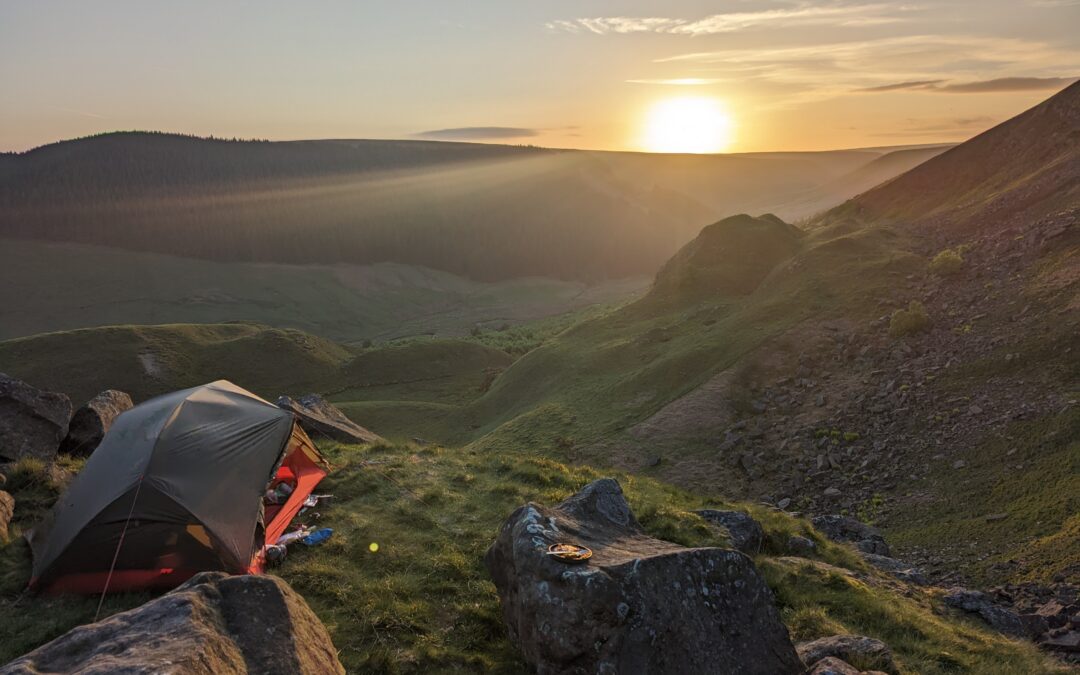
by Alan | Aug 18, 2023 | Discussion, Wild Camping
Freedom. Isn’t this what we all crave? And by freedom I don’t mean in the political sense, I mean freedom to roam and explore our own land; our own wilderness. Many don’t associate our small island with wilderness, people think of wilderness as being in far flung countries; desert, mountains and the like. But if we take some time explore our national parks, really explore them, our open spaces seem to become bigger and wilder as we explore more. We can do this by hillwalking of course and hillwalking is a wonderful way to spend the day and appreciate what we have. With hillwalking, however, we are always passing through. Sure, we can stop with a flask and sandwich, take some time and soak it up. However, to really appreciate the wild, it’s better to live in it for a short while. Putting up a tent and staying the night is living wild, even just for one night. By stopping and making a temporary home in the wild we can really begin to soak it up; watch the toing and froing of wildlife, see the arc of the sun casting ever changing shadows and listen; really listen. Wild camping, of course is the best way to do this. Sending multiple nights wild camping really makes the real world, the world of concrete and tarmac, melt away into the background. Living simply too, with just the basics in life; food, shelter and a warm sleeping back allows us to discard the clutter of modern life, take it back to basics. By spending time with just what you need to stay comfortable clears the mind and allows us to focus on what’s important in life. This is what wild camping brings and it’s the ultimate natural mental health care.
If we are going to talk about wild camping we need to talk about legalities. In England the only place you can officially legally wild camp is on Dartmoor in the South West. Even then, a landowner managed to ban it on a certain area of the moor – thankfully this ban was overturned in court, you can read more about that here.
So how do we do we wild camp if it’s not legal? Well in the rest of England wild caping is tolerated in national parks as long as it’s done responsibly and discreetly. This means camping away from the road and out of sight. It also means leaving no trace; no litter, no disposable BBQ use and only leaving a flattened patch of grass behind. Trespass is a civil offence meaning that even if you are approached by a landowner, they can’t physically move you on and you can’t be arrested by police for it (not that the police patrol the hills anyway). This however, is academic as in my 20+ years of wild camping I’ve never been approached, or spoked to by any landowner, famer, ranger or anyone else – and this is because I do it responsibly as I’m sure you would too.
So if you are thinking of camping wild, I really recommend it as away to connect with nature and get the best from our beautiful land – just be respectful an above all; leave no trace. Vango have a great article about leave no trace ethics here. Alpkit also have a great article about leave no trace principles here.
Enjoy the wild.

